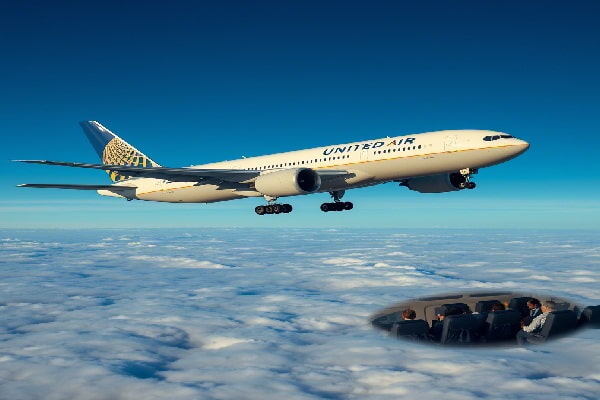When you’re cruising at 35,000 feet on a transatlantic flight, the last thing you expect is an emergency landing. But in 2025, that’s exactly what happened on United Airlines Flight UA770, which was supposed to travel from Barcelona El Prat Airport (BCN) to Chicago O’Hare International Airport (ORD).
Instead, the flight made an unscheduled stop at London Heathrow Airport (LHR) after a general emergency was declared mid-air. Thankfully, the plane landed safely, and no injuries were reported. But the unexpected diversion raised questions among travelers, aviation watchers, and even industry experts.
If you’re curious about what really happened and why, here’s a clear breakdown of the incident — in plain language — along with important context every frequent flyer should know.
The Unexpected Turn in Flight UA770’s Journey
United Flight UA770 was a routine long-haul service headed to Chicago from Barcelona. The flight was operated by a Boeing 787-9 Dreamliner, known for its modern technology and long-range capabilities.
Everything seemed normal until the pilots transmitted a “squawk 7700” — an emergency transponder code that immediately notifies air traffic control of a serious issue onboard. This alert essentially tells all aviation authorities, “We need help now.”
As a result, the flight was cleared to land at London Heathrow, a major international hub where United Airlines has ground support and maintenance teams ready to respond to emergencies.
What Does Squawk 7700 Mean?
The squawk 7700 code is universally recognized in aviation as a general emergency signal. It doesn’t specify the nature of the emergency — it could be mechanical, medical, or operational — but it instantly elevates the flight’s priority in all nearby airspaces.
Once that code is transmitted, air traffic controllers work quickly to find the best and safest airport for an emergency landing. In this case, Heathrow was the best option, offering both proximity and the necessary support services.
Also Read : Delta Flight DL275 to Tokyo Makes Emergency Turnaround, Diverts to LAX After 5 Hours
A Safe and Swift Landing at Heathrow
Flight UA770 landed safely on runway 27R at London Heathrow. Once on the ground, it taxied to Gate B44, where passengers were able to disembark calmly and without any injuries.
Although the reason for the emergency hasn’t been publicly confirmed, the airline chose to keep the plane grounded temporarily. United engineers and aviation experts inspected the aircraft thoroughly to determine the nature and extent of any issues before approving it to return to service.
How United Airlines Responded to the Situation
United Airlines hasn’t shared specific details about the emergency, which is not unusual while internal investigations are ongoing. However, based on passenger reports and tracking site updates, the airline acted quickly to assist affected travelers.
Here’s what happened next:
-
Passengers were guided through immigration and customs at Heathrow.
-
Alternate travel arrangements were made for many passengers, including rebooking on other flights to Chicago or nearby cities.
-
Hotel accommodations and food vouchers were reportedly provided, depending on the length of the delay.
Passengers praised the cabin crew’s calm communication and Heathrow staff’s cooperation during the unexpected landing.
Possible Causes Behind the Diversion
At this point, the exact cause of the emergency remains unconfirmed. Aviation forums and social media speculated on both mechanical and medical issues. Either scenario would justify a squawk 7700 emergency signal.
These are the most common reasons for such diversions:
-
Mechanical failure involving key systems (e.g., hydraulics, navigation, pressurization)
-
Medical emergencies where a passenger or crew member requires immediate attention
-
Smoke or unusual odors in the cabin
-
Technical alerts that could pose a safety risk if left unaddressed
Until United Airlines or official aviation authorities release an investigation report, the cause of UA770’s emergency landing will remain unclear.
Aircraft Details: Meet the Boeing 787-9 Dreamliner
The aircraft involved in the incident was registered as N26902, a Boeing 787-9 Dreamliner. This aircraft model is part of United’s modern long-haul fleet and is designed for efficiency and passenger comfort.
Key features of the Boeing 787-9:
-
Capacity: Around 250 to 296 passengers
-
Range: Up to 7,530 nautical miles
-
Technology: Advanced avionics, reduced noise, and fuel efficiency
-
Comfort: Larger windows, improved air pressure, and better humidity control
The Dreamliner is considered one of the safest and most advanced aircraft in commercial service. Incidents involving this aircraft are rare, and when they do occur, strict protocols are followed.
Why Was Heathrow Chosen for the Emergency Landing?
Some travelers wondered why the flight didn’t divert to a closer regional airport. Choosing London Heathrow was a smart move for several practical reasons:
-
It’s one of United Airlines’ major European hubs.
-
The airport has large runways that can easily handle wide-body aircraft like the Boeing 787-9.
-
Maintenance and engineering support are readily available on site.
-
Heathrow has the capacity and infrastructure to accommodate international passengers needing rebooking or assistance.
By landing at Heathrow, the airline ensured both passenger safety and logistical efficiency in handling the diversion.
Timeline Snapshot: UA770 Emergency Diversion at a Glance
| Detail | Information |
|---|---|
| Flight Number | UA770 |
| Airline | United Airlines |
| Aircraft Type | Boeing 787-9 Dreamliner |
| Registration | N26902 |
| Departure Airport | Barcelona El Prat (BCN) |
| Intended Destination | Chicago O’Hare International (ORD) |
| Diversion Airport | London Heathrow (LHR) |
| Runway Used | 27R |
| Emergency Declaration | Squawk 7700 |
| Gate After Landing | B44 |
| Year of Incident | 2025 |
| Injuries Reported | None |
| Official Cause | Still under investigation |
Why This Incident Matters: Broader Lessons from UA770
While emergency diversions like this are uncommon, they are a powerful reminder of how much planning, training, and coordination goes into commercial aviation. This situation showcases the value of:
-
Well-trained flight crews who know how to react under pressure
-
Reliable communication between pilots and air traffic control
-
Ground crews that can act swiftly to minimize disruption
-
Aircraft systems designed to detect and signal potential hazards early
In short, this incident shows that aviation safety protocols work — and they work well.
Conclusion: Safety First, Always
United Airlines Flight UA770’s emergency landing at London Heathrow was unexpected but handled with professionalism from start to finish. While the exact cause remains under investigation, what stands out is the crew’s fast response and the airline’s commitment to passenger well-being.
Nobody was injured. Passengers were supported. The plane landed safely. And once again, the airline industry proved that safety is always the top priority — even when things don’t go according to plan.
For travelers, it’s a reassuring reminder that modern aviation is prepared for the unexpected — and built to keep you safe, no matter where you’re flying.
Frequently Asked Questions
What caused United Airlines Flight UA770 to declare an emergency?
The specific cause has not been confirmed. A squawk 7700 signal was transmitted, which could indicate a mechanical or medical emergency.
Were there any injuries during the incident?
No. All passengers and crew disembarked safely at London Heathrow with no reported injuries.
Why was London Heathrow chosen instead of another nearby airport?
Heathrow was selected because of its size, facilities, open runways, and the presence of United Airlines staff and maintenance teams.
What kind of aircraft was involved?
The aircraft was a Boeing 787-9 Dreamliner, registered as N26902 — a long-range, fuel-efficient jet often used for international routes.
What happened to the passengers after the diversion?
While United Airlines hasn’t released a full statement, it is likely that passengers were rebooked on alternative flights or given accommodations, depending on individual travel needs.



